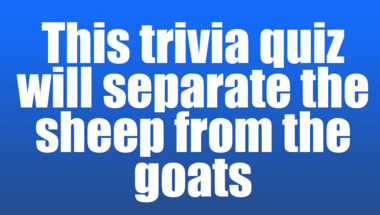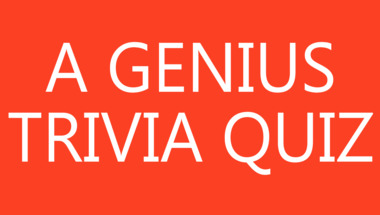

10 questions about mixed knowledge

10 mixed questions for you

10 questions than even a monkey can answer

10 mixed questions for you to have fun with

10 mixed questions

Can you name the artists?

- 10 questions -

10 mixed questions

10 questions about The King

Are you up for a quiz?

10 mixed questions

10 Impossible Questions

Try out this fun quick quiz

Let's see how smart you really are!

10 questions. Are you up for the challenge?

Ten questions for the smart quizzers

10 mixed questions

Get 8 right to taste the cheese!

How many songs can you sing along to?

10 songs to guess

10 questions to conquer

Let us know your score in the comments

10 questions

General knowledge for everyone

Tell us your result in the comments

10 questions

10 mixed questions

10 assorted questions

10 questions in mixed categories

10 questions. 10 songs. How many will you rem..

How many of these texts do you remember?

How many correct will you get?

Can you also score a solid 7/10?

How many of them will you answer correctly?

*** HOW HIGH CAN YOU SCORE? ***

10 questions to answer

How many of them will you answer correctly?

10 mixed up trivia questions

You won't get close to 10/10 in this quiz

by clicking here

10 questions to challenge your knowledge

10 random questions

Let's see how smart you really are!

How high can you score?

10 mixed general trivia questions

Post your score in the comments!

10 questions lined up

10 thrilling questions to have fun with

Are you the genius for this quiz?

Let me know your score in the comments

Test your knowledge with these 10 challenging..

10 expert questions

10 thrilling questions

Do you also love music from the 1960s?

10 mixed up questions

Let us know your final score in the comments ..

* 10 mixed general questions *

Are you a knowledge genius?

10 questions

Will you fail them all?

10 questions for you

You won't get close to 10/10 in this quiz

10 questions covering various categories

10 questions

10 Quite Difficult Questions

Tell us your result in the comments

10 fun questions

Please take 10 seconds to tell me your score ..

10 mixed questions

10 questions for food lovers and home cooks

10 mixed questions

Will this trivia quiz expose your inner moron..

Are you up for a quiz?

10 questions

10 questions

Trivia quiz right here

10 mixed fun questions

10 genius questions lined up

Do you have what it takes to master this triv..

Are you smart enough for this one?

Only members of the intellectual elite will s..

10 tasty questions

Can you score 6 or higher?

Let's see how smart you really are!

After taking the quiz, tell us your score in ..

10 mixed songs to guess

10 questions to test your knowledge

Can you score 6 or higher?

Can you guess these 10 singers/bands?

10 random questions

10 home chef questions

Are you a foodie?

How many correct answers will you get?

10 hot questions

10 fun questions

10 tasty questions

Let me know your low score in the comments :)

Can you score 8/10?

Can you go above 7 out of 10 correct answers?

Can you help us find the missing words?

How many correct will you get?

10 mixed questions

How high will your score be?

How smart are you really?

How many of them will you answer correctly?

10 mixed questions

Trivia quiz for experts

Let's see how much you know about food and co..

10 hot questions

10 songs to guess

10 mixed questions

10 fun questions

How big is your brain?

10 bands to guess

Are you up for a quiz?

10 interesting questions

What do you remember?

How many correct will you get?

10 questions

A quiz most people will fail

Trivia questions have long fascinated people, offering a delightful way to test and expand our knowledge across a wide variety of subjects. The following article delves deep into ten particularly intriguing trivia questions, exploring not just the answers but also the stories, history, and context behind each one. Whether you're a trivia enthusiast or just a curious reader, you'll find a wealth of interesting information in the details behind each question.
1. Which of these men was an English explorer in the 16th Century?
The 16th century was a golden age of exploration, particularly for England, as it sought to expand its influence and discover new trade routes. Among the most famous English explorers of this era was Sir Francis Drake. Drake was renowned for circumnavigating the globe between 1577 and 1580, a feat that made him a hero in England and a villain in Spain. He was also involved in the defeat of the Spanish Armada in 1588. Other notable explorers of this period include Sir Walter Raleigh, who attempted to establish the Roanoke Colony, and John Hawkins, who was a pioneer of the English slave trade. These explorers not only charted new territories but also set the stage for the British Empire’s global expansion.
2. What was the world population in 1970?
The world's population has grown exponentially over the past century, and 1970 marked a significant milestone. In that year, the global population reached approximately 3.7 billion people. This growth was fueled by improvements in medicine, agriculture, and sanitation, which reduced mortality rates and increased life expectancy. The 1970s also marked the beginning of serious discussions on population growth and its impact on resources and the environment, highlighted by the publication of the influential book The Population Bomb by Paul Ehrlich in 1968. Since then, the world population has continued to climb, surpassing 8 billion in the early 2020s.
3. Who played the lead in the '60s TV show 'The Fugitive'?
'The Fugitive' was a groundbreaking television drama that aired from 1963 to 1967. The lead role of Dr. Richard Kimble, a man wrongfully accused of murdering his wife and on the run to find the real killer, was famously played by David Janssen. The show's unique premise—featuring a protagonist constantly on the move and a storyline that spanned multiple seasons—captivated audiences and laid the groundwork for future serialized dramas. The final episode, in which Kimble finally confronts the one-armed man, was watched by more than 78 million people, making it one of the most-watched TV episodes in history.
4. How many spades are in a pack of cards?
A standard deck of playing cards contains 13 spades. Each suit—spades, hearts, diamonds, and clubs—has thirteen cards: Ace through 10, plus the Jack, Queen, and King. Spades are traditionally considered the highest-ranking suit in many card games, and their black color distinguishes them from the red suits of hearts and diamonds. The design of the spade is thought to have originated from the pike or spearhead, and its symbolism has ranged from representing nobility and military prowess to, in some contexts, death or the afterlife.
5. Which racing board game has a location called Gum Drop Mountain?
If you’ve ever played a colorful board game in your childhood, you might recall the magical world of Candy Land. Created in 1948 by Eleanor Abbott, Candy Land is a simple racing game aimed primarily at young children. One of its most memorable locations is Gum Drop Mountain, a whimsical spot on the winding path to King Kandy’s castle. The game, with its vibrant artwork and sweet-themed locations, became a cultural icon and has been enjoyed by generations of children. Gum Drop Mountain, with its candy-themed obstacles, epitomizes the fun and fantasy that defines the game.
6. How many times does the letter 'n' occur in the word 'nonannouncement'?
Let’s break down the word nonannouncement character by character: n-o-n-a-n-n-o-u-n-c-e-m-e-n-t. Counting each 'n', we find that it occurs 5 times in the word. This kind of question tests not only attention to detail but also patience, as it's easy to overlook a letter in a longer word. Such word puzzles are popular in spelling bees and language games, helping to sharpen focus and spelling skills.
7. Camels do not store water in their humps. They store…
A common myth is that camels store water in their humps, but in reality, their humps are made up of fat. This fat acts as a reserve of energy that camels can metabolize when food is scarce. When the fat is broken down, it does produce some water as a byproduct, but the primary function of the humps is fat storage. Camels are able to survive long periods without water thanks to their ability to tolerate dehydration and their unique adaptations, such as oval-shaped red blood cells that facilitate blood flow even when thickened by dehydration. This makes them ideal animals for desert environments.
8. What is the main source of water pollution in unindustrialised nations?
In many unindustrialised or developing nations, the primary source of water pollution is untreated human waste, also known as sewage. Lack of proper sanitation infrastructure means that human and sometimes animal waste often finds its way directly into rivers, lakes, and other water sources. This leads to the spread of waterborne diseases like cholera, dysentery, and typhoid fever, which can have devastating effects on public health. International organizations such as UNICEF and the World Health Organization have focused significant resources on improving sanitation and access to clean water in these areas.
9. Who was the first scientist to remove a brain and keep it functioning outside the body?
This remarkable scientific milestone was achieved by Robert J. White, an American neurosurgeon. In the 1960s and 1970s, White conducted pioneering experiments in which he removed the brains of animals (notably monkeys) and kept them alive outside the body using elaborate life-support machines. His work, while controversial, contributed to our understanding of brain physiology and transplantation. White’s research sparked ethical debates that continue in various forms today, particularly as science advances in the fields of organ transplantation and neural interfaces.
10. Amman is which country's capital city?
Amman is the capital city of Jordan. Located in the northwestern part of the country, Amman is one of the oldest continuously inhabited cities in the world. Today, it is Jordan’s political, cultural, and economic center, known for its ancient ruins, including the Roman Theater and the Amman Citadel, as well as its vibrant modern life. Over the years, Amman has grown rapidly, absorbing waves of immigrants and refugees, and playing a crucial role in Middle Eastern geopolitics.
These ten trivia questions touch on a remarkable range of topics, from history and geography to television, science, and language. Each answer opens a window into a broader story, illustrating how even simple questions can connect us to the complexity and wonder of the world. Whether you're preparing for your next quiz night or simply curious to learn more, exploring the stories behind trivia can be a rewarding journey in itself.